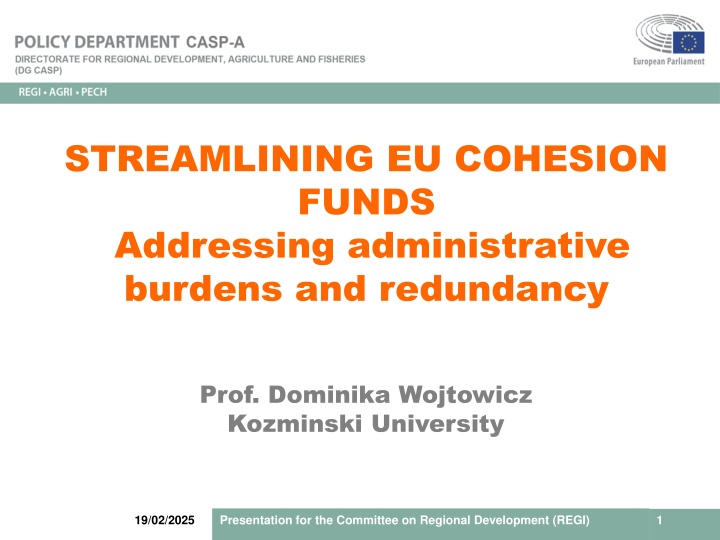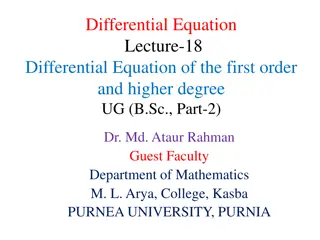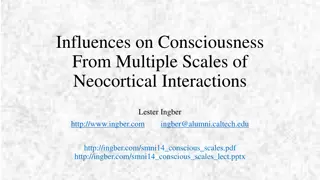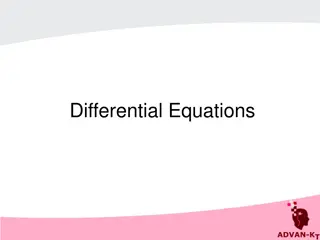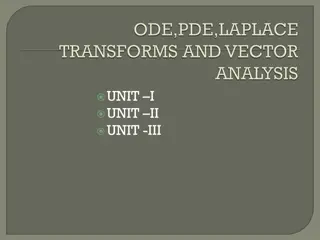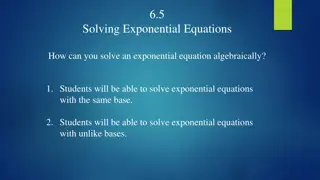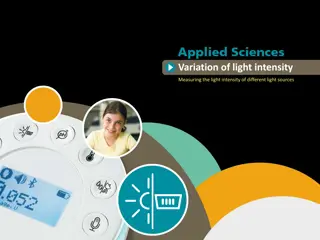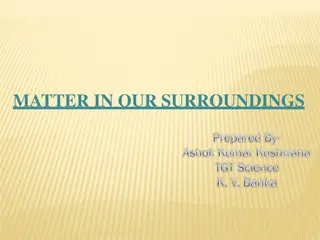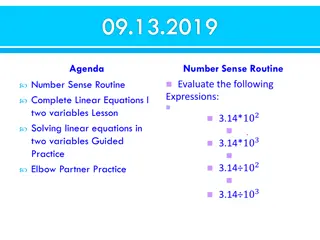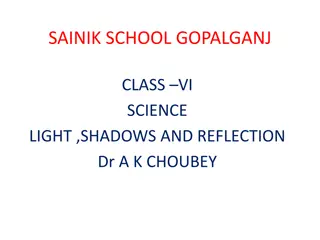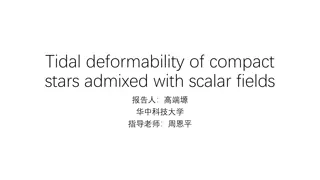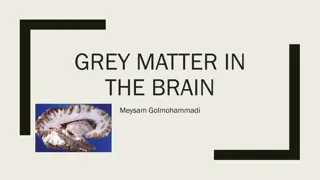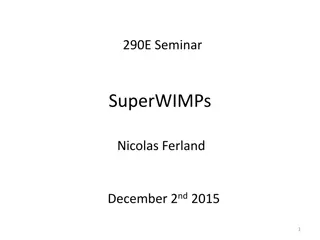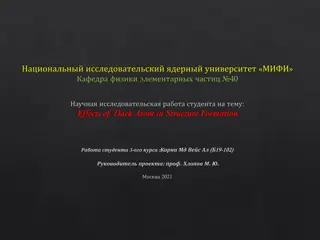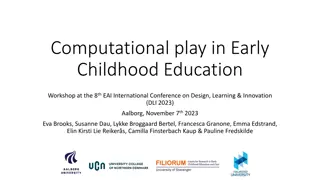Computational Light-Matter Interactions: Theoretical Solutions and Equations
Explore the fascinating world of Computational Light-Matter Interactions through theoretical solutions, equations, and parameter graphs. Dive into the complexities of energy levels, laser transitions, and decay rate calculations in this innovative field. Unravel the mysteries of light interacting with matter, supported by research from Kansas State University and the NSF grant.
Download Presentation

Please find below an Image/Link to download the presentation.
The content on the website is provided AS IS for your information and personal use only. It may not be sold, licensed, or shared on other websites without obtaining consent from the author.If you encounter any issues during the download, it is possible that the publisher has removed the file from their server.
You are allowed to download the files provided on this website for personal or commercial use, subject to the condition that they are used lawfully. All files are the property of their respective owners.
The content on the website is provided AS IS for your information and personal use only. It may not be sold, licensed, or shared on other websites without obtaining consent from the author.
E N D
Presentation Transcript
STREAMLINING EU COHESION FUNDS Addressing administrative burdens and redundancy Prof. Dominika Wojtowicz Kozminski University 19/02/2025 Presentation for the Committee on Regional Development (REGI) 1
Structure of the Presentation Structure of the Presentation 1. Purpose of the study 2. Simplification efforts since 2007 3. Administrative burdens and challenges 4. Complex network of ESIF and possibilities of consolidations 5. Recommendations 19/02/2025 Presentation for the Committee on Regional Development (REGI) 2
1. Purpose of the study 1. Purpose of the study Simplification efforts review of initiatives since 2007; Administrative barriers challenges for MAs and beneficiaries at the local level. ESIF landscape redundancies and opportunities for consolidation. Reducing burdens recommendations for improving fund implementation efficiency. CHALLENGES ADMINISTRATIVE COSTS ADMINISTRATIVE BURDENS 19/02/2025 Presentation for the Committee on Regional Development (REGI) 3
2. Main simplification 2. Main simplificationefforts since 2007 efforts since 2007 - Eligibility periods for expenditure extended; - Flexibility in fund reallocation; and - E-cohesion systems 2007-2013 - Simplified Cost Options (SCOs); - Single audit principle and proportional controls based on project size and risk. 2014-2020 - Further expansions of SCOs; - Digital tools for e-cohesion; - Harmonisation of rules across multiple funds; - Flexibility in programme management; - Streamlined eligibility rules. 2021-2027 19/02/2025 Presentation for the Committee on Regional Development (REGI) 4
3. 3. Administrative Administrative burdens burdens and and challenges challenges Workloads deriving from delays in the programming Constant lack of stable legal background Audits and controls EU regulations that fall outside the realm of CP Increasing complexity of CP 19/02/2025 Presentation for the Committee on Regional Development (REGI) 5
3. 3. Administrative Administrative burdens burdens and and challenges challenges Workloads deriving from delays in the programming 2021-2027 overlapping programming periods; parallel implementation of the Recovery and Resilience Facility (RRF); other initiatives channelled outside the CP (i.e. CRII/CRII+; REACT; CARE/FAST CARE). 19/02/2025 Presentation for the Committee on Regional Development (REGI) 6
3. Administrative 3. Administrative burdens burdens and and c challenges hallenges Constant lack of stable legal background modification of implementation system after a programming period begins implementation of STEP Regulation; Commission's clarifications are slow and non- binding. Increasing complexity of CP expansion of goals, stemming from secondary legislation (e.g. DNSH, horizontal principles). 19/02/2025 Presentation for the Committee on Regional Development (REGI) 7
3. 3. Administrative Administrative burdens burdens and and challenges challenges Audits and controls Accountability overload - multiple controls by different bodies; Unclear rules - no clear and binding interpretation of regulations; Sampling issues - errors in a sample may not reflect overall problems; Disproportionate penalties - minor erors can lead to excessive financial corrections; 19/02/2025 Presentation for the Committee on Regional Development (REGI) 8
3. Administrative 3. Administrative burdens burdens and and challenges challenges EU regulations that fall outside the realm of CP State aid rules complexity; Conflict of interest; Public procurement challenges; Gold-plating effect. 19/02/2025 Presentation for the Committee on Regional Development (REGI) 9
4. Complex network of ESIF: 4. Complex network of ESIF: possibilities for consolidations possibilities for consolidations 19/02/2025 Presentation for the Committee on Regional Development (REGI) 10
5. Recommendations 5. Recommendations Prior conditions to proposed simplifications Build broad political consensus on simplifications and improvements; Ensure continuity in delivering ESIF; Focus CP on core objectives; Develop genuine application of partnership and evidence-based approaches. 19/02/2025 Presentation for the Committee on Regional Development (REGI) 11
5. Recommendations 5. Recommendations Short-term recommendation for simplification Ensure a stable and timely delivered legislative package; Consolidate existing funds and cease creation of ad hoc funds; Include EAFRD under the CPR; Ensure clarity of regulations and eliminate legal uncertainties. 19/02/2025 Presentation for the Committee on Regional Development (REGI) 12
5. Recommendations 5. Recommendations Short-term recommendation for simplification Modify procedures and approach of audit and controls; Expand flexible approach to funding; Adopt beneficiary-friendly practices from directly managed programmes to ESIF; Abandon a silo approach to ESIF and operational programmes; Ensure continuous support for e-systems. 19/02/2025 Presentation for the Committee on Regional Development (REGI) 13
5. Recommendations 5. Recommendations Long-term recommendations for simplifications Implement permanent programmes with flexibility for adaptation; Adopt a result-based financing model for ESIF (similar to the RRF); Change the financing of CP: common debt/new forms of EU taxation. 19/02/2025 Presentation for the Committee on Regional Development (REGI) 14
Thank you! 19/02/2025 Presentation for the Committee on Regional Development (REGI) 15
